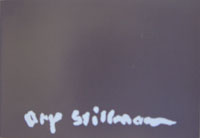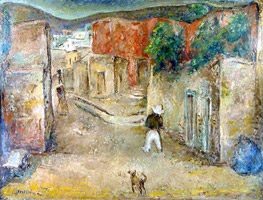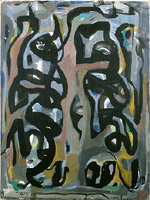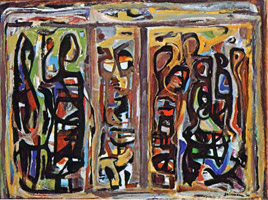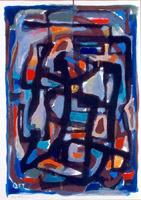
| E X H I B I T I O N S Ary Stillman's "Mexico
Years"
Stillman Art Portrays 'Inner Reality' By Marcia Goren Weser Ten years before his death in 1967, artist Ary Stillman retreated to Cuernavaca, just outside Mexico City. It was picturesque and peaceful, a perfect place to recover from a devastating eye injury and to regain the inspiration and enthusiasm needed to paint again. As well as having to cope with illness, Stillman had lost his New York studio and failed to find a place in his beloved Paris, where he had been critically acclaimed in the 1920s and ‘30s. He was able to paint again, finding ways to express "inner reality" during the next five years in his Mexico residency (1957-62), and some of the results can be seen in an exhibition now at the Jansen-Perez Gallery through Nov. 4. Only one work, a 1940 painting titled "Mexican Village," is representational; it is more tentative, hesitant in feeling, dating from his first visit to Mexico, as if he were depicting what he expected to see, rather than what he saw. His later drawings, gouaches and acrylics from the late ‘50s and early ‘60s are more vibrant, resembling stain-glass jewels of abstraction. It is as if he saw anew. Stillman was born near Slutzk, in White Russia, in 1891 and studied at the Imperial Art School in Vilna before coming to the United States in 1907. He attended the Art Institute in Chicago, the Jewish Educational Alliance and the Art Students' League in New York City before traveling throughout Europe and setting up a studio in Paris in 1921. He continued to live in Paris until 1933 (with the exception of spending 1929 in New York). There he exhibited in many group shows, including the celebrated Salon d'Automne (founded in 1903) which had held the first exhibits of the Fauves and later the Cubists. His first one-man show came in 1928 at the Galerie Bernheim-Jeune, which had been the site of the first Futurist show in 1912, and another in 1930 at Galerie Zak. Both were galleries known for avant-garde shows. Artists from the School of Paris, Modigliani, Soutine, Pascin, as well as Braque, Matisse, Cocteau, Derain, Leger and others could be seen there. It was an exciting time to be an artist in Paris. The works at Jansen-Perez show stylistic relationships to the historical movements of those times, yet they are uniquely of a different time and place. Layered and overpainted, the gouaches are more somber in feeling, darker gray grounds dissected, almost slashed, by black lines. These black lines occasionally read as figure in the gouaches, as in "Caprice" or the more colorful "Ritual." The figures become more rhythmic in "Procession" and more interrelational (almost narrative) in "Man and Woman" and "Group with Little Prince." Or they read as calligraphic marks, as in the dusky, almost brooding "Scherzo," one of the most abstract, and the most elegantly simple, in the show. With the addition of stronger colors and the overpainting, other works appear to glow with an inner light. These could be studies for stained-glass windows, not representational or thematic but about essence and existence. Stillman's drawings, most from a series called "Babylon," are darker than both the acrylics and gouaches, in tones of brown and beige, only one with dark greens and blues. Tumbling geometric shapes are defined as if by frottage, their edges hard and texture rich. These seem more like studies, as if Stillman were looking more at relationships among the elements than focusing on each separately. He seemed able then to take these shapes and redefine them, refining his vision according to his own order. He burst forth into color (especially in the acrylic paintings), reflecting what he saw in nature and his own explorations of dreams and the unconscious. Yet color never lapses into trite symbol in these paintings; instead color becomes a fresh, unexpected focus. In the catalog, his wife Frances Fribourg Stillman wrote of his delight in the outdoor cafes, in the gardens around their rented home; of their study of the Spanish language and the history of the region and its peoples, of European cultures as well. Her description of the impact of this environment on Ary Stillman may explain what viewers may recognize in his art: "All this fired Ary's imagination… (his) incredibly rich imagination began to reassert itself. Now, he fantasized, he had discovered through excavating among ancient ruins, a ‘palace of the prince' and everything that poured forth as he sat in the armchair in the corner of the verandah was something he carried away from the walls of this ancient palace… (it was) the beginning of the culmination of his entire career as a nonrepresentational painter." Some Exhibited Titles:
Click to see exhibition catalogue.
|
| © 2005 The Stillman-Lack Foundation, All text and images on this site may not be published, broadcast, or distributed in any form without the prior written permission of The Stillman-Lack Foundation. |
